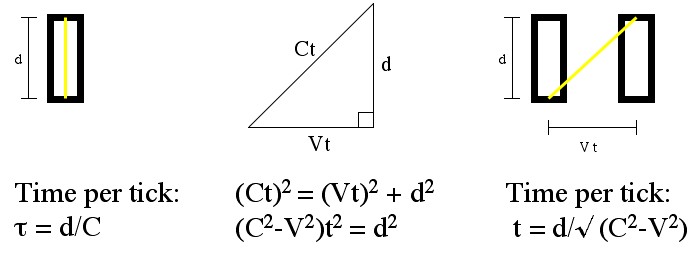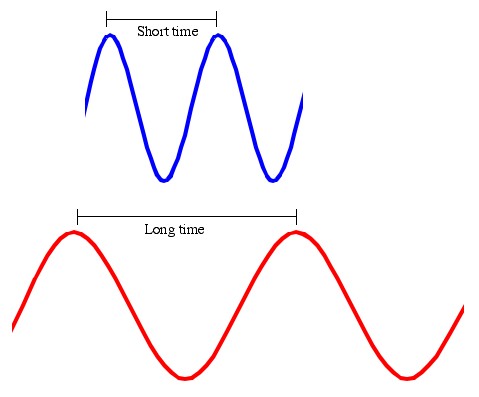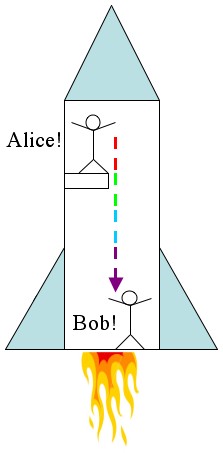Physicist: Back in the day, Galileo came up with the “Galilean Equivalence Principle” (GEP) which states that all the laws of physics work exactly the same, regardless of how fast you’re moving, or indeed whether or not you’re moving. (Acceleration is a different story. Acceleration screws everything up.) What Einstein did was to tenaciously hold onto the GEP, regardless of what common sense and everyone around told him. It turns out that the speed of light can be derived from a study of physical laws. But if physics is the same for everybody, then the speed of light (hereafter “C”) must be the same for everybody. The new principle, that the laws of physics are independent of velocity and that C is the same for everybody, is called the Einstein Equivalence Principle (EEP).
Moving faster makes time slow down: I’ve found that the best way to understand this is to actually do the calculation, then sit back and think about it. Now, if a relativistic argument doesn’t hinge on the invariance of C, then it isn’t relativistic. So ask yourself “What do the speed of light and time have to do with each other?”. A good way to explore the connection is a “light clock”. A light clock is a pair of mirrors, a fixed distance apart, that bounce a photon back and forth and *clicks* at every bounce. What follows is essentially the exact thought experiment that Einstein proposed to derive how time is affected by movement.

The proper time "τ" is how long it takes for the clock to tick if you're moving with it. The world time "t" is the time it takes for the clock to tick if you're moving with a relative velocity of V.
Let’s say Alice is holding a light clock, and Bob is watching her run by, while holding it, with speed V. Alice is standing still (according to Alice), and the time, , between ticks is easy to figure out: it’s just
. From Bob’s perspective the photon in the clock doesn’t just travel up and down, it must also travel sideways, to keep up with Alice. The additional sideways motion means that the photon has to cover a greater distance, and since it travels at a fixed speed (EEP y’all!) it must take more time. The exact amount of time can be figured out by thinking about the distances involved. Mix in a pinch of Pythagoras and Boom!: the time between ticks for Bob. So Bob sees Alice’s clock ticking slower than Alice does. You can easily reverse this experiment (just give Bob a clock), and you’ll see that Alice sees Bob’s clock running slow in exactly the same way.
It turns out that the really useful quantity here is the ratio: . This equation is called “gamma”. It’s so important in relativity I’ll say it again:
.
It may seem at first glance that the different measurements are an illusion of some kind, like things in the distance looking smaller and slower, but unfortunately that’s not the case. For Alice the light definitely travels a shorter distance, and the clock ticks faster. For Bob the light really does travel a greater distance, and the clock ticks slower. If you’re wondering why there’s no paradox, or want more details, then find yourself a book on relativity. There are plenty. Or look up Lorentz boosts. (The very short answer is that position is also important.)
The lower the slower: Less commonly known, is that the lower you are in a gravity well, the slower time passes. So someone on a mountain will age (very, very slightly) faster than someone in a valley. This falls into the realm of general relativity, and the derivation is substantially more difficult. Einstein crapped out special relativity in a few months, but it took him another 10 years to get general relativity figured out. Here’s a good way to picture why (but not quite derive how) acceleration causes nearby points to experience time differently:
Alice and Bob (again) are sitting at opposite ends of an accelerating rocket (that is to say; the rocket is on, so they’re speeding up). Alice is sitting at the Apex (top) of the rocket and she’s shining a red light toward Bob at the Bottom of the rocket. It takes some time (not much) for the light to get from the Apex of the rocket to the Bottom. In that time Bob has had a chance to speed up a little, so by the time the light gets to him it will be a little bit blue-shifted. Again, Alice sees red light at the Apex and Bob sees blue light at the Bottom.

Counting the blue crests is faster than counting the red crests. However, since it's all the same light beam the number of crests has to be the same to everybody.
The time between wave crests for Bob are short, the time between wave crests for Alice are long. Say for example that the blueshift increases the frequency by a factor of two, and Alice counts 10 crests per second. Then Bob will count 20 crests per second (No new crests are being added in between the top and the bottom of the rocket). Therefore, 2 seconds of Alice’s time happens in 1 second of Bob’s time. Alice is moving through time faster.
Einstein’s insight (a way bigger jump than the EEP) was that gravitational acceleration and inertial acceleration are one and the same. So the acceleration that pushes you down in a rocket does all the same things that the acceleration due to gravity does. There’s no way to tell if the rocket is on and you’re flying through space, or if the rocket is off and you’re still on the launch pad.
It’s worth mentioning that the first time you read this it should be very difficult to understand. Relativity = mind bending.








Pingback: Q: According to relativity, two moving observers always see the other moving through time slower. Isn’t that a contradiction? Doesn’t one have to be faster? « Ask a Mathematician / Ask a Physicist
Pingback: Q: Why does E=MC2 ? | Ask a Mathematician / Ask a Physicist
Pingback: Q: Why does going fast increase an object’s mass? | Ask a Mathematician / Ask a Physicist
Pingback: Q: How do velocities add? If I’m riding a beam of light and I throw a ball, why doesn’t the ball go faster than light? | Ask a Mathematician / Ask a Physicist
Pingback: Q: How can wormholes be used for time travel? | Ask a Mathematician / Ask a Physicist
Pingback: Q: If a photon doesn’t experience time, then how can it travel? | Ask a Mathematician / Ask a Physicist
Pingback: Q: Satellites experience less time because they’re moving fast, but more time because they’re so high. Is there an orbit where the effects cancel out? Is that useful? | Ask a Mathematician / Ask a Physicist
Pingback: Q: Since the Earth is spinning and orbiting and whatnot, are we experiencing time wrong because of time dilation? | Ask a Mathematician / Ask a Physicist